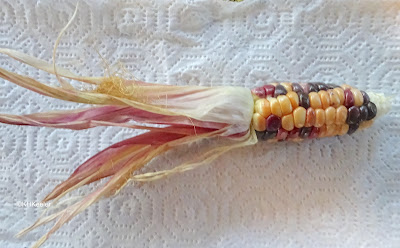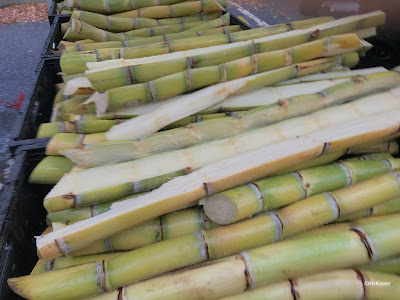In the novel I published this winter, I imagined an elderly Spanish woman visiting central South America in 1630. Although fascinated by tales of the Americas, she had never traveled beyond Spain. In the early 17th century, the Americas were old news but European daily life was still largely untouched. For example, most American foods were not immediately attractive to Europeans. The few that were instant hits, chocolate and vanilla for example, were in such short supply initially that even the kings of Spain had to ration their consumption lest it run out before the next ship.
 |
| freshly roasted cacao beans (chocolate) Theobroma cacao |
From south Florida to about Buenos Aires, Argentina, Central and South America are tropical and subtropical. The plants of Spain, a dry, temperate Mediterranean climate, rarely grew well in the tropics. In my story, and in reality, as Europe became farther and farther away, the foods of necessity changed to tropical American foods, most of them unfamiliar.
Since Roman times, Spain was a major producer of wheat (Triticum spp.). In the tropics, wheat generally died, destroyed by wet weather and diseases. Americans in the subtropics and tropics made flour from corn (Zea mays) or cassava (also called manioc and yuca, Manihot esculenta). Lacking the gluten necessary to rise, these formed flat breads or porridges. If your palate was used to wheat and oats, corn and cassava flours taste pretty strange.
 |
| Corn |
And I imagined trying to describe a corn cob. What European thing is it like? What would you say? (No specialized words like cob or kernel allowed).
Tropical Americans also had sweet potatoes as a source of starch. But the European diet of the time lacked starchy root vegetables, white potatoes still being largely unknown. If your experience cooking root vegetables was with beets and turnips, what would you do with a sweet potato? Boil it and get a revoltingly soft mass, not a tender beet?
Fruits and vegetables were also mainly different. Again, European colonists brought seeds from home, but the conditions were different enough that only the toughest, onions (Allium cepa) for example, prospered. The fruits of the tropics remain exotic to most people from temperate regions. We can refrigerate and ship some of them all around the world before they rot today. In 1630, even dried fruit usually rotted on the sea voyage to or from Europe. They didn't do much better with live plants in the 1600s: the deck of a ship was too sunny, the hold too dark, salt water (and salt spray) were toxic to plants, often fresh water was in too short supply to share with plants. Then they landed in cold, dark Europe. Lots of tropical plants went all around the world in the 1500s, but those were going to a place where the climate was similar. Successful importation of important tropical and subtropical plants to temperate Europe took decades to accomplish and, generally, worked well only after the development of greenhouses in Europe.
So, in 1630 as today, visitors to the Caribbean or subtropical South America find unfamilar foods. Fruits like custard apples (Annona cherimola), soursops (Annona muricata), a dozen different pineapples (Ananas comossus), a dozen colors of papayas (Carica papaya), passionfruits (Passiflora species)...wow. (And today Old World tropical fruits like mangoes Mangifera indica and bananas Musa species).
 |
| custard apple, Annona cherimola, for breakfast |
One difference from visiting the tropics in 1630 versus today is that they would have delighted in the sugar. We take it for granted. The medieval European diet was poor in sweets. Honey was not abundant. Sugar cane (Saccharum offinarum) was grown in the few places suitable for it around the Mediterranean, but despite high demand, there simply wasn't much suitable land. That changed radically when the Americas were discovered. All the Caribbean and lots of land on the continent of Central and South America could grow sugar cane and Europe was hungry for it. Historians describe raising sugar cane for rum, but before that, it made sugar affordable. Imagine landing in the Caribbean and for the first time in your adult life being able to eat all the sugar--as candies, spread on other foods, in drinks--that you wanted. Even stodgy adults would rejoice.
 |
| sugar cane, Saccharum officinarum, precious sweets |
I wrote the novel as a travel journal, from Seville to Havana, to Buenos Aires to Asuncion...so much for a traveler to discover. As always some unfamiliar foods are a delight, some too strange. Travel has things you love, things you dislike, and things you never imagined, now and 400 years ago.
I love travel, real and imagined.
Book: I Have Seen Marvels, A Journey to Paraguay 1630. by Kathleen Keeler. Available on Amazon link
Comments and corrections welcome.
Origins of our foods, see for example B-E van Wyk. 2005. Food Plants of the World. Timber Press. Portland, OR. Or do a web search for the food you are curious about.
Also:
Dunmire, W. W. 2004. The Gardens of New Spain. University of Texas Press, Austin TX.
I enjoyed your book, and recommended it to a friend (also a botanist).
ReplyDeleteHey, Kathleen. Looking forward to your book. Just one thing, Spain has a wide variety of climates, ranging from Atlantic temperate in the North to semi-tropical in the islands. Take care!
ReplyDelete